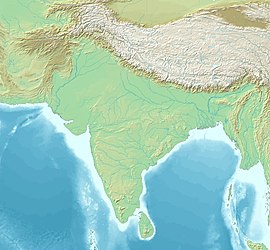Our website is made possible by displaying online advertisements to our visitors.
Please consider supporting us by disabling your ad blocker.
Second Battle of Tarain
| Second Battle of Tarain | |||||||||
|---|---|---|---|---|---|---|---|---|---|
| Part of Indian campaigns of Muhammad of Ghor | |||||||||
 The last stand of Rajputs, painted by Allan Stewart for Hutchinson & co. | |||||||||
| |||||||||
| Belligerents | |||||||||
| Ghurid Empire | Rajput Confederacy | ||||||||
| Commanders and leaders | |||||||||
|
Muhammad Ghuri Qutubuddin Aibak Bahauddin Tughril Husain Kharmil Taj al-Din Yildiz Nasir ad-Din Qabacha Muhammad bin Mahmud Khalji Mukalba Kharbak[1] |
Prithviraj Chauhan Govind Rai † Samantsingh † [2] Badamsa Rawal Bhola Vijayraj †[3] Harapal Parmar † Rajpal Parmar † Rana Motishvara †[4] | ||||||||
| Strength | |||||||||
|
Numerically inferior[5] 120,000 (according to Minhaj)[6][7] |
Numerically superior[8] 300,000 (likely exaggeration)[a][10][b] | ||||||||
| Casualties and losses | |||||||||
| Unknown | 100,000 according to Hasan Nizami[11] | ||||||||
Location of the Second Battle of Tarain | |||||||||
The Second Battle of Tarain was fought in 1192 between the Ghurid forces of Muhammad Ghuri and the Rajput Confederacy of Prithviraj Chauhan. It took place near Tarain (modern Taraori), which is 110 kilometres (68 mi), north of Delhi. The battle ended in a decisive victory for the invading Ghurids and their successful penetration in north Indian plain.
The battle is regarded as a watershed event in Medieval India history as it led to the destruction of Rajput powers for a while and laid the foundation of Muslim rule in North India, which led to the establishment of Delhi Sultanate.[12][13]
- ^ K. A. Nizami 1992, p. 162, 172:"Muizzuddin's army had four veteran war-lords of Ghazni-experienced, determined and desterous--Kharbak, Kharmil, Ilah, Mukalba. Each had under his command a huge army, Besides them there were--Tajuddin Yalduz, Qubacha and Aibek. The Sultan started from Ghazni in 587/1191, reached Tarain in 588/1191-92 and pitched his tent at the same place where he had suffered a serious defeat a year before. According to Ferishta, 150 Rajput rais had come to the feld with Rai Pithora, determined to crush or be crushed :-Bakhtiyar did not belong to an obscure family. His uncle, Muhammad bin Mahmud, had fought against Prithvi Rai at the second battle of Tarain"
- ^ Rima Hooja 2006, p. 349.
- ^ K. A. Nizami 1992, p. 164:"The details supplied by Isami about the actual disposition of the armies are more interesting. According to him Govìnd Rai was the mugaddam of the Rajput forces. He fought in advance of Pithoras army; Pithora fought in the centre. The left wing of Pithora's army was under Bhola, who was the wazir; the right wing was led by Badamsa Rawal"
- ^ R. V. Somani 1981, p. 62: "The Paramara Rajputs held Badlu, Phalodi etc. under them. Parmar Harpapal and Rajpal of Badlu gave away their lives in the battlefield of Tarain in 1192 A.D...Rana Motishvara and his son Vijayraj gave their lives in the second battle of Tarain"
- ^ Kaushik Roy 2014, p. 23:"We can speculate that the Rajput Army was numerically superior to the Ghorid army"
- ^ Satish Chandra 2006, p. 25.
- ^ Kaushik Roy 2014, pp. 22–23.
- ^ Kaushik Roy 2014, p. 23:"We can speculate that the Rajput Army was numerically superior to the Ghorid army"
- ^ Satish Chandra 2006, pp. 25–26.
- ^ Kaushik Roy 2014, p. 23:"We can speculate that the Rajput Army was numerically superior to the Ghorid army"
- ^ Dasharatha Sharma 1959, p. 86: "Prithviraja was asleep, the Rajput soldiers were just moving out for their daily ablutions and other morning duties. Having thus taken by surprise, the Rajputs could not have escaped considerable losses, but they could still have drawn themselves into fighting order, if the well thought out strategy of Muhammad Ghori had not lured and drawn them out into an unsystematic and ill-advised pursuit. The Rajputs were completely routed, losing about 100,000 men according to Hasan Nizami.
- ^ Sugata Bose; Ayesha Jalal (2004). Modern South Asia: History, Culture, Political Economy. Psychology Press. p. 21. ISBN 978-0-415-30786-4.
It was a similar combination of political and economic imperatives which led Muhmmad Ghuri, a Turk, to invade India a century and half later in 1192. His defeat of Prithviraj Chauhan, a Rajput chieftain, in the strategic battle of Tarain in northern India paved the way for the establishment of the first Muslim sultanate
- ^ Rima Hooja 2006, p. 458: "..Nevertheless, the battle, as far as the Rajput powers were concerned, was not so destructive as the battle of Tarain between Prithviraja III and Muizuddin Ghori. Though it weakened the power of the kingdom of Mewar and lowered its general prestige, it did not destroy the grip of the Sisodias over their kingdom, nor did it affect the social and economic conditions of life in the state"
Cite error: There are <ref group=lower-alpha> tags or {{efn}} templates on this page, but the references will not show without a {{reflist|group=lower-alpha}} template or {{notelist}} template (see the help page).
Previous Page Next Page



